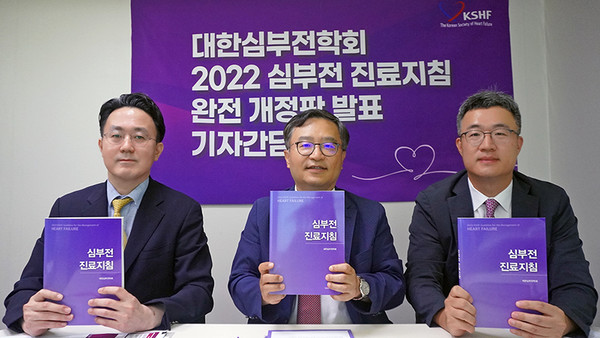The Korean Society of Heart Failure (KFHS) said it published the “2022 Complete Revision of Heart Failure Treatment Guidelines,” containing 10 important treatment changes.

The newest guideline is the first completely revised heart failure treatment guideline in six years.
“Heart failure is a disease that will increase explosively in the future aging population,” KFHS Chairman Kang Seok-min said during a press conference on Friday. “Fortunately, since the KFHS published its first revised domestic heart failure treatment guidelines, various new drugs and various treatments have been introduced.”
However, there are still many cases where patients miss the proper treatment time due to poor initial treatment, Kang added.
Kang stressed that with the recent full revision of the association’s guideline, he hopes that the prognosis and quality of life of patients with heart failure in Korea will improve by using the newly introduced advanced treatment methods.
The newly published 2022 guideline has over 300 pages and 64 chapters reflecting all the changes over the past five to six years and recent global research results.
Major revisions include the definition and classification of heart failure, diagnosis algorithm for heart failure, treatment of heart failure with reduced ejection fraction, change in the role of heart failure drugs, improved ejection fraction reduction in heart failure patients, mild reduction of ejection fraction and preservation of ejection fraction treatments related to heart failure, treatment of comorbidities in heart failure patients, diagnosis and treatment of cardiac amyloidosis, the timing of referral to all tertiary hospitals and heart failure specialists, and treatment of acute heart failure patients and severe heart failure.
“We have updated the newly revised guideline from the definition of heart failure to the classification of heart failure,” said Professor Cho Hyun-jae of the Department of Cardiology and KFHS director of medical guidelines. “We have also changed the treatment and drug recommendations.”
According to Cho, heart failure was classified as heart failure with a mid-range ejection fraction (HFmrEF) when the cardiac ejection fraction was between 41-49 percent. It was understood as a disease close to heart failure with preserved ejection fraction (HFpEF).
HFpEF is a clinical syndrome in which patients have signs and symptoms of heart failure due to high left ventricular (LV) filling pressure despite normal or near-normal LV ejection fraction.
“However, as recent studies have reported similar effects to drug treatment of heart failure with reduced ejection fraction (HFrEF) in heart failure patient group, the classification was changed to heart failure with mildly reduced ejection fraction (HFmrEF), which is closer to HFrEF,” Cho said.
Cho noted that the new guidelines had recommended appropriate therapies and medications according to the changed heart failure classification.
“Positive clinical results were announced in HFpEF, which had unmet demand due to the lack of a suitable treatment, and new treatments have emerged, and the heart failure treatment environment is developing,” Cho said. “Therefore, KFHS has developed a standardized best heart failure treatment guideline for Koreans, beyond accepting and adapting the heart failure guidelines revised in Europe in Sep. 2021 and the U.S. in April 2022.”
For HFrEF, angiotensin receptor neprilysin inhibitor (ARNI) or angiotensin-converting enzyme inhibitor, beta blocker, saline corticoid receptor antagonist, and sodium-glucose cotransporter 2 (SGLT2) inhibitor were recommended as standard of care, Cho added.
Cho explained that if the ejection fraction continued to decrease despite standard medications, the guideline recommends treatments such as ivabradine, vericiguat, or digoxin as second-line treatments.
“For HFmrEF and HFpEF, we recommend diuretics, SGLT2 inhibitors, and angiotensin receptor-neprilysin inhibitors (ARNIs) as major treatments,” the professor said.

